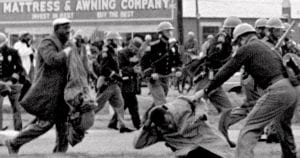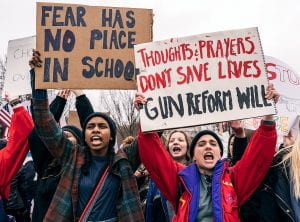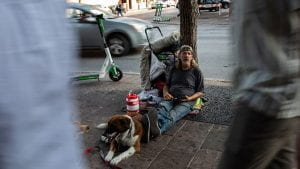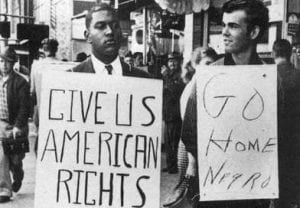The Last MARCH
Dear John Lewis,
Reading MARCH has made me really reconsider what I knew about the civil rights movement. I had learned about it in school but looking back it was a very watered down version of everything that had happened. Their were so many people involved, both in leadership and tragedy, that I had never even heard of before reading your story. I feel like I understand the struggle more after reading a first hand account of all the events that lead up to the signing of the Voting Rights Act.

With the assassinations of Malcolm X and Jimmie Lee Jackson, everything only got worse with the violence on Bloody Sunday. It was so shocking to see the police so violently assault such peaceful protesters. It was especially ironic because the protesters were praying. So many people were sent to the hospital and moral seemed to be broken. Even so, on March 21 they marched again all the way to Selma. The dedication everyone showed to the cause is extremely admirable

Even though voting isn’t an issue anymore, our world is filled with inequalities. Now more than ever we need to remember to fight for what is right. We have to remember that everything we have now, we have because someone stood up and said it was what we deserved. We can not be scared to fight against the inequalities of the world. If MARCH has taught me anything it is that we need to always do what we can to better the world.
Thank you,
Jennifer Wang
What Happens in Woodruff Park
I am a freshman at Georgia State University majoring in Political Science. My major requires me to understand how people live affects their decisions. I have taken several classes that analyze behavior in different types of people, such as Comparative Culture, which focuses on police behavior. I spend a lot of time watching people and trying to understand how and why they do the things they do.
Woodruff Park is a small park located on the edge of Georgia State University’s Atlanta campus. Half of the park is filled with flower beds with vibrant flowers and large trees and the other half is paved with stone and has a giant fountain. The fountain rests on the edge of one side of the park like a boarder and is several feet tall. The fountain simulates a man made waterfall. Around the waterfall is almost a pond and it usually has a handful of colorful leaves floating in the water. At the center of the fountain, there is a tiny green door that is apart of the Tiny Doors Atlanta project. The park isn’t surrounded by very tall buildings so for most of the day, the park is in full sunshine. Because of all the sun, for the most part, people in the park tend to stay under the shade of the trees but a couple will sit on the edge of the fountain. Usually the people sitting on the fountain are hanging around the edge of the park, rather than the center.
The Park isn’t filled with people, but everyday a couple hundred people pass by and through the park. Sometimes, people will stop and sit on the fountain. They sit and scroll through their phones for a while and eat before heading out of Woodruff park.

Many homeless people stay in Woodruff Park throughout the day, at least a dozen. They sit and lay near the trees, rarely going near the center of the park or by the fountain. Several of them lay down on the edge of the brick flower beds, wrapped in jackets and blankets trying to take naps under the shade of the trees between the hustle and bustle of the chilly city. They keep their things very close to them, usually at their feet or by their heads, stuffed into backpacks or trash bags or shopping carts. Their carts and bags are overflowing with piles of clothes and nik-nacs. The ones that are awake are watching their things and tend to keep their heads down, not interacting with anybody in the park. When people walk by they look down, trying to avoid eye contact. The people walking by don’t say anything as they pass by. A homeless man is sitting on the edge of the stairs at the entrance to the park brushing his teeth. He is dressed in a gray hoodie, sweats and sneakers with a backpack open next to him. Two women walk by him after taking a picture of the tiny door in the fountain and exhibit this exact behavior, not even sparing him a glance. This behavior continued with more people in the park, from students rushing by to men sitting down to have lunch.
Most of the people passing through are young students trying to get to class or back to their dorms. Some students are by themselves, but some walk in groups and chat as they walk; sometimes the students stop and smoke before

continuing on their way. The students don’t tend to pay much mind toward other people that they do not know. A few students ride through on the city scooters that are scattered around the city. Most go straight through Woodruff Park, not paying much mind to what is going on around them. One student stops periodically as he rides through the park, he stops and pulls out his phone and take selfies. He doesn’t seem to pay any mind to the homeless people sitting next to him as he clicks away. He crosses through the entire park without paying any mind to the homeless men, or anyone else for that matter. A group of students come by and one of the students pose in front of the fountain while the others help them take pictures of them. But after that, they leave very quickly, not paying any mind to the homeless men a few feet away. A shirtless man walked up to the fountain and dunked his hair in it a couple of times and then picked up one of two shirts sitting on the fountain. He then put on the shirt and proceed to walk along the fountain’s edge out of the park. No one seemed to take notice. If anyone had noticed, they didn’t say or do anything.
People don’t seem to be concerned with anything going on in the park that doesn’t involve them. They seem to be in too much of a hurry to slow down and talk to each other, or even take notice of each other; perhaps they are just wary of strangers. Everyone who walked through the park seemed to all exhibit the same behavior on their walks. Most people are on their phones and have their earbuds in and did not speak to anyone other than the people they were already with. It seemed like they didn’t want to be disturbed. People seem to be too preoccupied with what they are doing to notice the other people in the park. Everyone walking through the park took notice of the homeless men, very briefly. However, acknowledging their presence is all the interaction amounts to. They don’t seem to pay mind to what any of them are doing or how they appear. They all just casually walked around them and continued on their way.
What I witnessed in the park was that people seemed to be very closed off to the people around them. Any moment that could lead to any human interaction is ignored. The way people do on a day to day basis reflects how they will act when the stakes are upped. How everyone acted in the park was concerning because even the most subtle of interactions, or lack thereof, leaves to people becoming desensitized to each other. And the more people become desensitized to each other, the less sympathetic they become. If people become desensitized to each other, the larger issues that we as a society are less likely to care about the problems of others and that in itself is a major problem. As a society, we need to be more willing to interact with each other in order to improve larger issues.
Keep Fighting
Dear John Lewis,
This part of MARCH, an election for the Presidency is riling everyone up. Once again, the right to vote is brought up. Several people faced horrible atrocities just for wanting to be able to register to vote in the election. It’s horrific to think that people would attack African Americans for asking to be allowed to vote for their President. It makes me sick just thinking about it. All that struggle and they still lost. It must have felt so defeating.
You traveled around the world advocating for your cause as things in the US continued to decline. The SNCC was buckling under its weight and the more than joined, the harder it was to make decisions. They were split on everything. Groups can often be split from movements, it happens all the time now. A small but vocal minority can paint a bad picture of the whole movement. It’s happened with things like the femanist movement and other similar ones. The story continues to escalate, small victories are nice but that’s not what they want anymore. They just want to be equal. It’s awful to think simple actions like going through the front door could escalate into police violence and arrest.
MARCH continues to push the idea of protesting for change. That waiting isn’t the right way to make things happen, and no matter what the opposing side throws at you keep pushing forward. Even now, in a day and age where there is more equality than ever, inequality is still rampant and we can not just settle for small victories.
Thank you,
Jennifer Wang

Change Happens Through Protest
Dear John Lewis,
This section of MARCH was infuriating and depressing to read. Reading about the trials of African Americans as they fought for their right to vote and to end segregation broke my heart. It’s appalling to look back and see just what the police and other whites were willing to do to keep African Americans as essentially second class citizens. And even after Kennedy’s assassination and Johnson’s push for equality, things like literacy test still stood in the way of equality. The worst thing was remembering than most of the things the police did had been completely legal; I have to wonder if it was your intention to re enforce the idea that just because something is legal does not mean it is moral.
One thing that was completely gut wrenching was when the 3 kids when to Mississippi to volunteer for Freedom Summer and disappeared. The vile actions of the police made me infuriated that someone would kill 3 people in cold blood to try and deter others from fighting for their rights. It hit me particularly hard when the members of the SNCC explained that things like that would continue to happen but the ends would justify the means. Even with all the protests, inequality still stood.
MARCH has really been pushing the idea of fighting for your rights and standing your ground. Even when it seemed futile, they pushed on because nothing was going to change if they didn’t take it for themselves. I definitely think that is a lesson that will continue to be relevant for decades to come, especially since a lot of new laws have felt like a backslide of human rights in the past few years. What is legal is not always what is right and we have to remember that we cannot give in to discrimination no matter what.
Thank you,
Jennifer Wang

Civil Rights
Dear John Lewis,
MARCH thus far has made me feel shocked and appalled that these terrible acts could have ever taken place. The church bombing had me almost in tears; I couldn’t believe anyone would have enough hatred to do something like that. The violation of human rights made me so angry, especially that the officers who shot a child never got convicted. I could never understand how someone could think so little of another group of people, and the people in charge saw no real reason to enact change. I feel as though one of the reasons the children committing hate crimes was added in to show how deep racism ran. Children only know what is taught to them, and they were taught hate.
This story made me think a lot about racism more in depth because racism is now very heavily frowned upon but back then it was the norm. But even with that social shift things like this happen all the time to all minorities. Minorities deal with hate crimes and are still fighting for their rights but the majority of people are unwilling to help them.
To help these issues we must protest against these injustices. If the people in charge do not want to make changes, we as a society are responsible for demanding changes.
Thank you,
Jennifer Wang

My Favorite Fairy Tale
I would say I have a pretty obsessive personality. When I love something, I love it with all my heart. I learn absolutely everything I can about it and it’s basically my favorite thing in the world. But the only thing I can think of that has spanned my whole life, without me even realizing it, is theatre.

It started when I was 5. Every spare moment of everyday I would beg my mom to play my favorite movie The Little Mermaid. Every time my mom popped it into the DVD player and the opening played my eyes would light up and I would be entranced. Maybe it was because of the pretty mermaids or the fun sea creatures, but I loved this movie more than anything else. Anytime a song would start I would sing along. I have always liked singing but these songs brought out the performer in me. My sister and I would jump around the living room from couch to couch belting out a, very likely off-key, rendition of ‘part of your world’ and dance around stupidly to ‘under the sea’. Sometimes we would even try our hand at a scary evil ‘poor unfortunate soul’. The little mermaid was my first taste of what a musical could do. How exciting and engaging something could be with a little song and dance; I would go through about 12 different emotions repeatedly in the span of an hour and a half long movie. I was in love with musicals and I didn’t even know what they were called yet. In hindsight, this was the first indication that I would be a weird theatre kid.
Hello world!
Welcome to your brand new blog at sites@gsu.edu!
To get started, edit or delete this post and check out all the other options available to you.
For assistance, visit the comprehensive support site, check out the Edublogs User Guide guide or stop by The Edublogs Forums to chat with other edubloggers.
For personal support, you can attend Georgia State’s training on Edublogs or stop by The Exchange for one-on-one support.
You can also reference the free publication, The Edublogger, which is jammed with helpful tips, ideas and more.